| Contents
Home
General
Info
Ordering
Info
Contact us
Cartridge
Lists
Patent & Miscellaneous
Rim Fire
Center Fire Pistol
Center Fire Rifle
Metric Rimfire,
Pistol&Rifle
British Pistol and Rifle
Shotgun Shells
Cartridge Boxes &
Related
Posters
This Month's Picture Page
Index to
Picture Pages
Prior Picture Pages:
*
September 2003
*
October 2003
*
November 2003
*
December 2003
*
January 2004
*
February 2004
*
March 2004
*
April 2004
*
May 2004
*
June 2004
*
July 2004
*
August 2004
*
September 2004
*
October 2004
*
November 2004
*
December
2004
*
January 2005
*
February
2005
*
March
2005
*
April
2005
*
May 2005
* June 2005
* July 2005
*
August 2005
*
September
2005
*
October 2005
*
November 2005
*
December 2005
*
January 2006
*
February 2006
*
March 2006
*
April 2006
*May 2006
*June 2006
*July 2006
*August
2006
*September
2006
*October
2006
*November
2006
*December
2006
*January
2007
*February
2007
*March
2007
*April
2007
*May
2007
*June
2007
*July
2007
*August
2007
*September
2007
*October
2007
*November
2007
*December
2007
*January
2008
*February
2008
*March
2008
*April
2008
Links to Other Sites
Cartridge Collectors Organizations:
IAA
ECRA
SAAACA
Auctions:
Auction
Arms
E-Bay
Ward's Collectibles
Sold USA
Books:
Armory
Publications
WCF Publications
Other Collector's Sites:
Curtis Steinhauer
|
Home of the Old Ammo Guy's Virtual
Cartridge Trading Table
Picture
Page
May 2008
The first .38 Smith & Wesson
cartridge............
The .38 Smith & Wesson is one of the most commonly encountered cartridges
today, having been in continuous production since 1875 in the United States,
as well as having been produced in a number of other countries. Most
American handgun makers sold revolvers chambered for this cartridge,
including large numbers of the cheap 'Saturday night specials'. When I have
a table at our local gun show, it seems like two out of three people who
come by looking for information on Grandpa's old gun have one of these
clunkers, and more often than not, its chambered for the
.38 S&W. Being a very common cartridge, it is seldom that one is encountered
that has much value or warrants a second look. An exception is what is
considered to be the first of
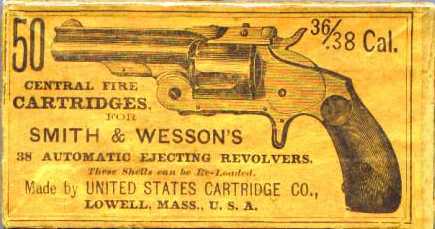 the
commercially produced .38 S & W cartridges, as made by the United States
cartridge company in 1876 specifically for Smith & Wesson. A picture of the
rare box for these cartridges is shown here. The pistol illustrated on the
label is the .38 Smith & Wesson Model 2 single action revolver,
affectionately referred to by collectors as the Baby Russian because, aside
from its spur trigger, it is essentially a scaled down version of the S&W
.44 New Model Russian revolver. This was the first revolver to use the .38
S&W center fire cartridge. The the
commercially produced .38 S & W cartridges, as made by the United States
cartridge company in 1876 specifically for Smith & Wesson. A picture of the
rare box for these cartridges is shown here. The pistol illustrated on the
label is the .38 Smith & Wesson Model 2 single action revolver,
affectionately referred to by collectors as the Baby Russian because, aside
from its spur trigger, it is essentially a scaled down version of the S&W
.44 New Model Russian revolver. This was the first revolver to use the .38
S&W center fire cartridge. The
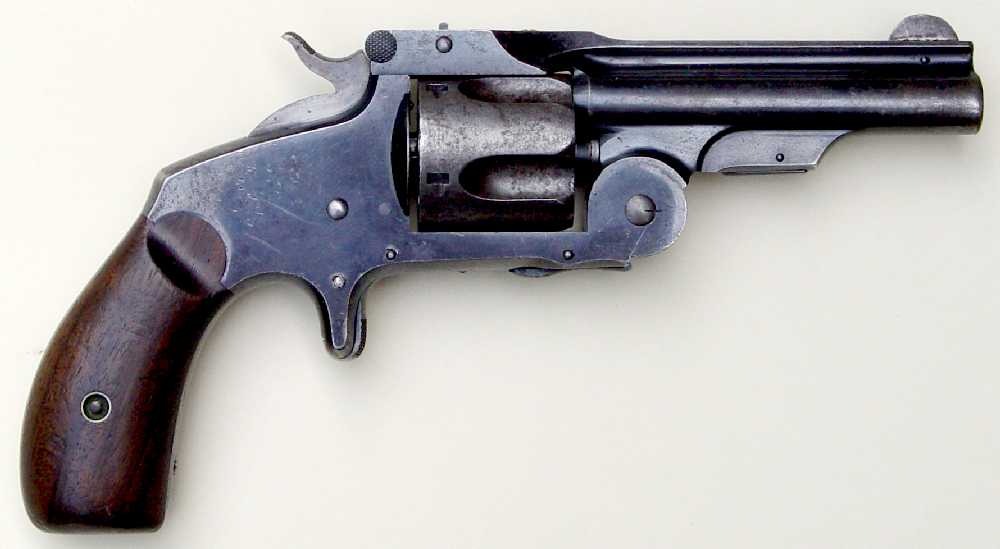 evolution
of the revolver is somewhat unusual; the cartridge was developed first, and
then the firearm was designed to shoot it. The revolver shown in this
picture, is serial number 2023 and was made during the first year of
production. Of the approximately 25,500 of these revolvers made during its
two years of production (1876 and
1877), only 6,500 had a blued finish and walnut grips, the balance being
nickeled with hard rubber grips. evolution
of the revolver is somewhat unusual; the cartridge was developed first, and
then the firearm was designed to shoot it. The revolver shown in this
picture, is serial number 2023 and was made during the first year of
production. Of the approximately 25,500 of these revolvers made during its
two years of production (1876 and
1877), only 6,500 had a blued finish and walnut grips, the balance being
nickeled with hard rubber grips.
 The caliber (36/.38) that is marked on the box label is odd by today's
standards, but can
be readily understood when it is pointed out that all of the standard .38 caliber
Smith & Wesson cartridges (.38 S&W, .38-44, and .38 Special) used bullets
that were closer to .36 caliber than .38, and at the time this box was made,
the conventions to be used for center fire caliber designations were still
being established. The cartridges that were packaged in these early United
States Cartridge Company boxes are pretty unique and as a result are fairly
easy to recognize. Unlike the round nose, un-grooved bullets found on most
.38 S&W cartridges, the bullets on these have a flat nose, like those on .38
Colt The caliber (36/.38) that is marked on the box label is odd by today's
standards, but can
be readily understood when it is pointed out that all of the standard .38 caliber
Smith & Wesson cartridges (.38 S&W, .38-44, and .38 Special) used bullets
that were closer to .36 caliber than .38, and at the time this box was made,
the conventions to be used for center fire caliber designations were still
being established. The cartridges that were packaged in these early United
States Cartridge Company boxes are pretty unique and as a result are fairly
easy to recognize. Unlike the round nose, un-grooved bullets found on most
.38 S&W cartridges, the bullets on these have a flat nose, like those on .38
Colt New Police bullets, and
a single groove. The groove is unusual, having a sharp front edge, and a
long beveled rear edge. The brass case has the characteristics of other
early United States Cartridge Company cases, these being a reddish color to
the brass, a result of the high copper content, rounded heads, and flat, copper
Farrington primers. New Police bullets, and
a single groove. The groove is unusual, having a sharp front edge, and a
long beveled rear edge. The brass case has the characteristics of other
early United States Cartridge Company cases, these being a reddish color to
the brass, a result of the high copper content, rounded heads, and flat, copper
Farrington primers.
.
A box from South of the Border..........

This box of cartridges, made by Productos Regiomontano of Monterrey, Mexico,
is labeled .44 S&W Corto (short), a name I had not heard of before, perhaps
used to distinguish it from the longer .44 S&W Special cartridge. The red
and green box has a
 definite
Remington Kleanbore 1950s to early 60s look; the end flaps are even
formatted definite
Remington Kleanbore 1950s to early 60s look; the end flaps are even
formatted
 like
the Remington boxes. The similarity suggests the possibility that Remington
was in some way associated with the Mexican company. In addition to the
characteristics of the box, the headstamp on the cartridges mimics the
R-P headstamp that Remington started using in the 1960s, but with the
letters reversed. If anyone has any material that would substantiate a
connection between Remington and Productos Regiomontano, I'd appreciate
hearing about it. Apparently, Remington had at least one subsidiary in
Mexico, that being Cartuchos Deportivos de Mexico, S. A., the company that
produced the Auto-Mag cartridges with the headstamp CDM. .44 AUTO MAG. like
the Remington boxes. The similarity suggests the possibility that Remington
was in some way associated with the Mexican company. In addition to the
characteristics of the box, the headstamp on the cartridges mimics the
R-P headstamp that Remington started using in the 1960s, but with the
letters reversed. If anyone has any material that would substantiate a
connection between Remington and Productos Regiomontano, I'd appreciate
hearing about it. Apparently, Remington had at least one subsidiary in
Mexico, that being Cartuchos Deportivos de Mexico, S. A., the company that
produced the Auto-Mag cartridges with the headstamp CDM. .44 AUTO MAG.
.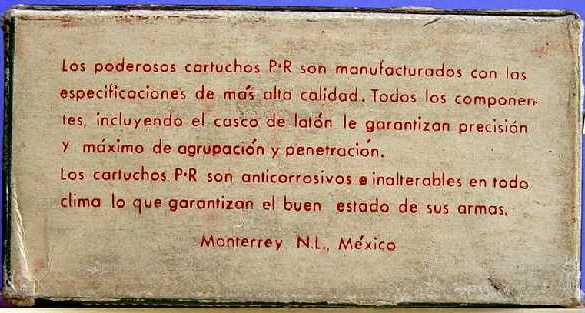
.
.
.
.
.
.
.
.
.
.
A little something for the beer
drinkers........

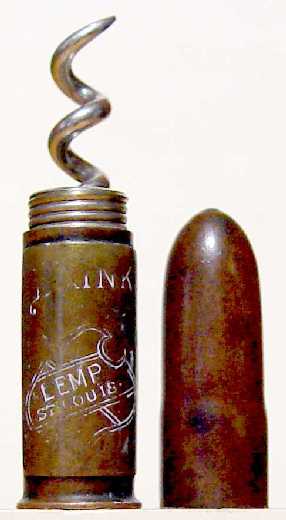
Here's an addition to my growing collection of cartridge-related bar
paraphernalia. This cartridge shaped
corkscrew advertises Lemp's beer on the small engraved plaque soldered to
the side of what would serve as the case for the cartridge. The worn
engraving says 'DRINK LEMP ST. LOUIS'. On the
bottom, it is marked 'WILLIAMSON CO. PATENTED JUNE 9, 97
NEWARK, N.J.'. The bullet end unscrews from the case and the corkscrew is
pulled out and swung to the side to fit in a groove, and the bullet is
screwed back in place to serve as part of the handle. I had never considered
that beer might have been put up in corked bottles - I just took it as
a given that the bottles have always had caps. Obviously, this was not the
case, as attested to by this little corkscrew that was designed to fit
comfortably in one's pocket, ready to be swung into action at a moments
notice, while reminding him to drink the beer that St. Louis was known for
at the turn of the 20th century. I, for one, had
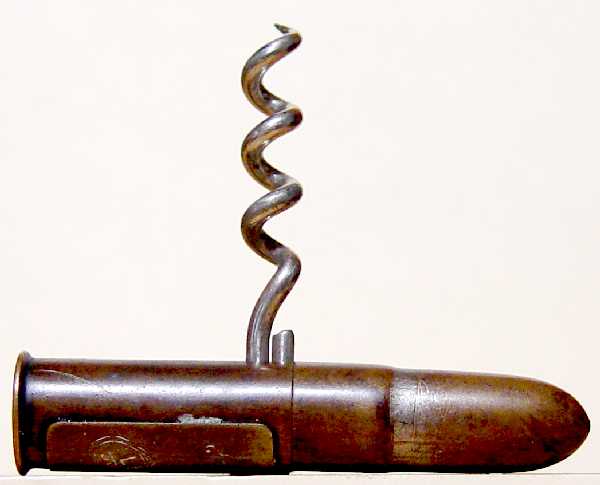 never
heard of Lemp's beer, so I was in for a good education when I Googled 'Lemp
beer'. To make a long story involving German immigrants, Falstaff beer,
limestone caverns, untimely deaths, and fortunes miss-spent short, Lemp became the largest brewer
in that city, and their beer was the first to be distributed coast-to-coast,
becoming the most popular brand in the nation in the 1890s. Who knew?? never
heard of Lemp's beer, so I was in for a good education when I Googled 'Lemp
beer'. To make a long story involving German immigrants, Falstaff beer,
limestone caverns, untimely deaths, and fortunes miss-spent short, Lemp became the largest brewer
in that city, and their beer was the first to be distributed coast-to-coast,
becoming the most popular brand in the nation in the 1890s. Who knew??
.
.
.
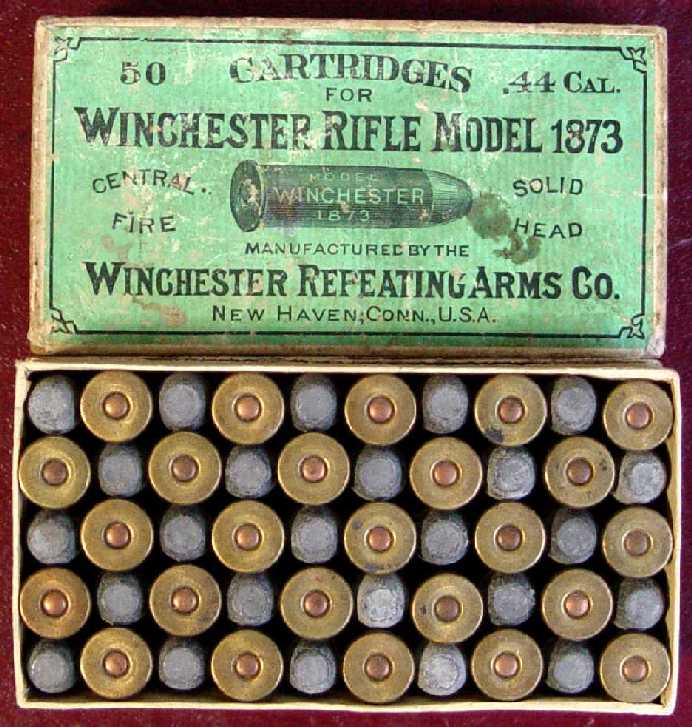
|

 the
commercially produced .38 S & W cartridges, as made by the United States
cartridge company in 1876 specifically for Smith & Wesson. A picture of the
rare box for these cartridges is shown here. The pistol illustrated on the
label is the .38 Smith & Wesson Model 2 single action revolver,
affectionately referred to by collectors as the Baby Russian because, aside
from its spur trigger, it is essentially a scaled down version of the S&W
.44 New Model Russian revolver. This was the first revolver to use the .38
S&W center fire cartridge. The
the
commercially produced .38 S & W cartridges, as made by the United States
cartridge company in 1876 specifically for Smith & Wesson. A picture of the
rare box for these cartridges is shown here. The pistol illustrated on the
label is the .38 Smith & Wesson Model 2 single action revolver,
affectionately referred to by collectors as the Baby Russian because, aside
from its spur trigger, it is essentially a scaled down version of the S&W
.44 New Model Russian revolver. This was the first revolver to use the .38
S&W center fire cartridge. The

 definite
Remington Kleanbore 1950s to early 60s look; the end flaps are even
formatted
definite
Remington Kleanbore 1950s to early 60s look; the end flaps are even
formatted
 like
the Remington boxes. The similarity suggests the possibility that Remington
was in some way associated with the Mexican company. In addition to the
characteristics of the box, the headstamp on the cartridges mimics the
R-P headstamp that Remington started using in the 1960s, but with the
letters reversed. If anyone has any material that would substantiate a
connection between Remington and Productos Regiomontano, I'd appreciate
hearing about it. Apparently, Remington had at least one subsidiary in
Mexico, that being Cartuchos Deportivos de Mexico, S. A., the company that
produced the Auto-Mag cartridges with the headstamp CDM. .44 AUTO MAG.
like
the Remington boxes. The similarity suggests the possibility that Remington
was in some way associated with the Mexican company. In addition to the
characteristics of the box, the headstamp on the cartridges mimics the
R-P headstamp that Remington started using in the 1960s, but with the
letters reversed. If anyone has any material that would substantiate a
connection between Remington and Productos Regiomontano, I'd appreciate
hearing about it. Apparently, Remington had at least one subsidiary in
Mexico, that being Cartuchos Deportivos de Mexico, S. A., the company that
produced the Auto-Mag cartridges with the headstamp CDM. .44 AUTO MAG.
